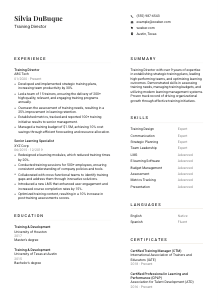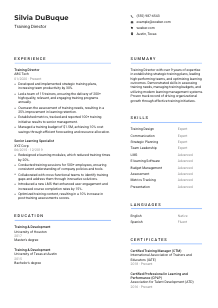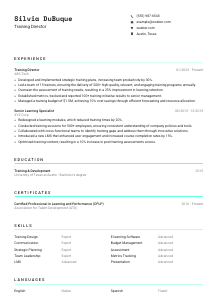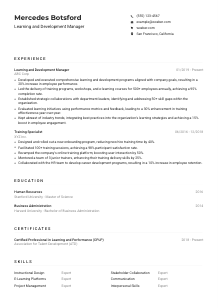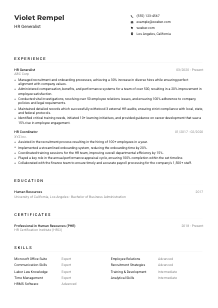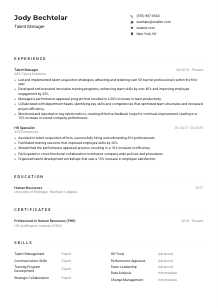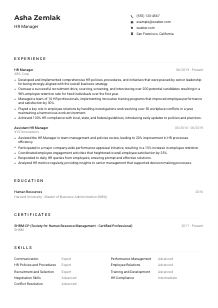Training Director CV Example
Charting training strategies, but your CV feels unplanned? Browse this Training Director CV example, orchestrated with Wozber free CV builder. Learn how to structure your training symphony to harmonize with job requisites, ensuring your career crescendos to new professional heights!
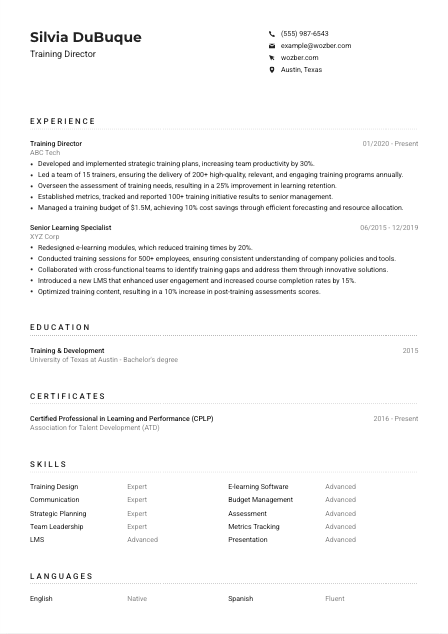
How to write a Training Director CV?
Welcome, aspiring Training Director! In the realm of training and development, how you present your skills, experience, and strategic approach on your CV can set you apart in a fiercely competitive landscape. Crafting a CV that resonates with hiring managers requires more than just listing your professional journey; it involves a strategic alignment of your career narrative with the role's requirements.
By leveraging the power of Wozber free CV builder, equipped with an ATS-compliant CV feature and a dedicated ATS CV scanner, we will guide you through tailoring your CV for the role of a Training Director. Embark on this journey with us to ensure your CV not only meets but exceeds expectations.
Personal Details
First impressions count, especially on your CV. Let's customize your personal section to immediately signal to employers you're a top contender for the Training Director position. A well-crafted personal section draws the reader in, making them eager to learn more about your professional narrative.
1. Name and Brand
Begin with your name, clearly and boldly presented. Think of your name as your personal brand logo that grabs attention. It's essential that it stands out, so consider using a slightly larger font size than the rest of the CV.
2. Precise Job Title
Directly below your name, include the job title you're aiming for - in this case, 'Training Director'. This immediately informs the hiring manager of your career aspirations and aligns your application with the job posting.
3. Contact Details
Ensure your contact details are up to date and professional. A phone number and a professional email address following the format firstname.lastname@email.com are sufficient. Remember, simplicity in your contact information facilitates ease of contact.
4. Location Relevance
If the job requires being located in or willing to relocate to a specific location, such as Austin, Texas for the Training Director role, make sure to include your city and state of residence to confirm your availability or willingness to relocate.
5. Professional Online Presence
Including a link to your professional online profile or personal website can provide a fuller picture of your professional persona. Ensure your LinkedIn profile is polished and mirrors your CV's information.
Takeaway
Your personal section is not just routine information; it's the doorway to your professional story. Make every detail count, ensuring accuracy, relevance, and alignment with the Training Director role you're eyeing. It sets the tone for the rich narrative that follows. With each detail, you're inviting the hiring manager to read on.





Experience
The Experience section is where you illuminate your professional journey, strategically highlighting the experiences that showcase your fitness for the Training Director role. Tailoring this section involves weaving your achievements into the fabric of the job description.
- Developed and implemented strategic training plans, increasing team productivity by 30%.
- Led a team of 15 trainers, ensuring the delivery of 200+ high‑quality, relevant, and engaging training programs annually.
- Overseen the assessment of training needs, resulting in a 25% improvement in learning retention.
- Established metrics, tracked and reported 100+ training initiative results to senior management.
- Managed a training budget of $1.5M, achieving 10% cost savings through efficient forecasting and resource allocation.
- Redesigned e‑learning modules, which reduced training times by 20%.
- Conducted training sessions for 500+ employees, ensuring consistent understanding of company policies and tools.
- Collaborated with cross‑functional teams to identify training gaps and address them through innovative solutions.
- Introduced a new LMS that enhanced user engagement and increased course completion rates by 15%.
- Optimised training content, resulting in a 10% increase in post‑training assessments scores.
1. Decode the Job Description
Examine the job description thoroughly. Identify key responsibilities and required experiences. For a Training Director, this includes developing strategic training plans, leading a team of trainers, and managing a training budget.
2. Structure with Insight
List your experiences in reverse-chronological order, starting with your most recent role. Clearly state your job title, the company's name, and the period of your employment. This structure ensures a smooth narrative flow.
3. Reflect the Role
For each role, craft accomplishment statements that resonate with the requirements for a Training Director. Detail how you developed training plans, the size of teams you've led, and the scope of training budgets you've managed, including measurable impacts.
4. Quantify Your Impact
Numbers speak louder than words. Quantify your successes, such as 'Led a team of 15 trainers, ensuring the delivery of 200+ high-quality, relevant training programs annually.' This provides concrete evidence of your capabilities.
5. Relevancy is Key
Focus solely on experiences that highlight your qualifications for the Training Director position. Irrelevant accomplishments might clutter your CV, diluting the impact of your most pertinent contributions.
Takeaway
Your experience section is a showcase of your most relevant professional achievements. By carefully aligning this section with the job's requirements, you demonstrate your capability and readiness for the Training Director role. Keep your narrative focused, impactful, and quantified to capture the attention of hiring managers.
Education
The Education section of your CV is more than a list of degrees; it's a reflection of your foundational knowledge and commitment to your field. For a Training Director, highlighting relevant educational achievements is essential to establishing your qualifications.
1. Match the Job's Educational Requirements
Identify the educational qualifications listed in the job description, such as a Bachelor's degree in Training & Development or a related field. Make sure your highest level of education is in line with or exceeds these requirements.
2. Simple, Yet Informative
Present your educational background in a straightforward format: degree, field of study, institution, and graduation date. This clarity ensures the hiring manager can quickly assess your qualifications.
3. Tailor to the Role
In case the job description prefers a Master's degree, and you have it, prominently feature this qualification. Highlighting a degree in Training & Development directly ties your educational background to the specific demands of the position.
4. Coursework and Achievements
For roles that emphasize particular educational backgrounds, listing relevant courses or academic achievements can be beneficial. However, for a seasoned Training Director, focusing on degrees and relevant certifications might be more appropriate.
5. Beyond Academics
If applicable, mention any extracurricular leadership roles or project work related to training and development. This can add depth to your academic profile, showing early signs of leadership and initiative.
Takeaway
Your education section should reflect a strong foundation in training and development, underscoring your suitability for the Training Director position. Keep this section concise yet impactful, making it clear you possess the theoretical knowledge to complement your practical skills.
Certificates
In the evolving field of training and development, staying abreast of the latest methodologies and earning relevant certifications can significantly enhance your CV. Let's strategically highlight certifications that underscore your expertise and dedication.
1. Highlight Pertinent Certifications
Reflect on the job description's requirements. If certifications like Certified Professional in Learning and Performance (CPLP) are mentioned as a plus, and you have them, ensure these are clearly listed on your CV.
2. Prioritize Relevance
Select certifications that are directly relevant to the role of a Training Director, focusing on quality over quantity. This ensures that hiring managers immediately see the value and relevance of your additional qualifications.
3. Transparency with Dates
If your certification has an expiration date or if it's a recent achievement, include this information. This transparency shows your commitment to maintaining and updating your professional knowledge.
4. Continuous Learning
Emphasize your dedication to professional growth by updating your certifications and pursuing new ones that are relevant to your career as a Training Director. This demonstrates an ongoing commitment to excellence in your field.
Takeaway
Certifications are a testament to your dedication to professional development and expertise in the training field. By carefully selecting and presenting relevant certifications, you bolster your CV and affirm your readiness for the Training Director role.
Skills
Your Skills section is a compact, potent representation of your professional toolkit. Tailoring this section for the Training Director role means highlighting the hard and soft skills that are crucial for success in this dynamic position.
1. Pinpoint Essential Skills
Extract key skills from the job description, such as expertise in Training Design, Strategic Planning, Budget Management, and proficiency with Learning Management Systems (LMS). These skills should be prominently featured in your CV.
2. Prioritize Pertinence
Concentrate on listing skills that are directly relevant to the Training Director role. For a robust skills section, combine both hard skills like LMS proficiency and soft skills like effective communication and team leadership.
3. Clarity and Impact
Organize your skills in a clear, easy-to-read format, possibly using bullet points. This organisation ensures the hiring manager can quickly understand the depth and breadth of your professional capabilities.
Takeaway
The skills section of your CV is a focused snapshot of the professional tools you bring to the table. By highlighting skills that align with the Training Director position, you signal to hiring managers your comprehensive readiness and strategic fit for the role.
Languages
In our increasingly globalized world, language skills can be an added boon, especially in roles that may involve working with diverse teams or designing training for international audiences. Skillfully presenting your language proficiencies can add an extra layer of appeal to your CV.
1. Match Job Language Requirements
Firstly, note any specific language requirements or preferences from the job description. For the Training Director position, proficiency in English is a must. Ensure this is clearly indicated on your CV.
2. Organize by Proficiency
List languages in order of proficiency, starting with your native language. Use standardized terms like "native," "fluent," "intermediate," and "basic" to describe your level of fluency, making sure these are easily understood.
3. Showcase Additional Languages
Even if the job description doesn't specify other languages, having additional language skills can be a significant asset, particularly in organisations with a global footprint. List these languages, indicating your level of proficiency for each.
4. Honest Self-Assessment
Be truthful about your level of language proficiency. Overstating your abilities can lead to awkward situations, while undervaluing them might sell you short. Honest self-assessment is key.
5. Evaluate the Role's Demands
Consider whether the Training Director role involves international engagement or multicultural teams. If so, your ability to communicate in multiple languages may significantly enhance your candidacy.
Takeaway
Language skills reflect your ability to engage with a variety of cultures and teams, an increasingly valuable asset in global roles. By thoughtfully including your linguistic capabilities, you present yourself as a well-rounded and adaptable candidate, ready to take on the challenges of a Training Director.
Summary
A compelling Summary section ties together your professional narrative, emphasizing your suitability for the Training Director role. This section serves as your CV's headline, capturing the essence of your professional identity.
1. Capture the Job's Essence
Digest the job description to understand the core requirements and responsibilities of the Training Director role. This insight will help you draft a summary that resonates with the specific needs of the position.
2. Lead with Your Identity
Begin your summary with a clear statement of your professional identity, such as 'Training Director with over 9 years of expertise'. This establishes your position within the field right from the start.
3. Highlight Matching Qualities
Weave in your most relevant skills and achievements, focusing on those that match the job description. Mention your experience in developing strategic training plans, leading teams, and managing budgets to show your alignment with the role's requirements.
4. Conciseness is Key
While it's tempting to detail every accomplishment, a summary needs to be concise. Aim for three to five sentences that spotlight your core competencies and distinguish you as an exemplary candidate for the Training Director position.
Takeaway
The Summary section is more than an introduction; it's your professional anthem that sings of your strengths, achievements, and readiness for the role of Training Director. Approach it as a strategic, concise narrative that invites hiring managers to learn more about your profound capabilities. Let it set the stage for the detailed excellence that follows in your CV.
Launch Your Quest for Training Director Mastery
Congratulations on completing this essential guide to tailoring your CV for the Training Director role! Armed with insights and equipped with the free CV builder from Wozber, including ATS-friendly CV templates and an ATS CV scanner, you're ready to draft a CV that not only aligns with job requirements but also showcases your unique professional prowess. Remember, your CV is a powerful tool in your career arsenal – use it to tell your story, highlight your achievements, and open doors to new opportunities.
Your journey to leadership in training and development begins now. Embrace your expertise, and let your CV be the key that unlocks your next rewarding position.

- Bachelor's degree in Training & Development, Human Resources, or a related field.
- Master's degree is preferred.
- Minimum of 8 years of experience in training design, delivery, and evaluation, with at least 3 years in a leadership or managerial capacity.
- Strong proficiency in using Learning Management Systems (LMS) and e-learning software.
- Excellent communication, presentation, and facilitation skills, with the ability to engage diverse audiences.
- Certification in Training and Development (e.g., Certified Professional in Learning and Performance - CPLP) is a plus.
- Must have the ability to communicate in English effectively.
- Must be located in or willing to relocate to Austin, Texas.
- Develop and implement strategic training plans to meet the organization's changing needs and objectives.
- Lead a team of trainers, ensuring the delivery of high-quality, relevant, and engaging training programs.
- Oversee the assessment of training needs and the planning and execution of training content and materials.
- Establish metrics to track the effectiveness of training initiatives and report results to senior management.
- Manage the training budget, including forecasting, resource allocation, and cost control.





